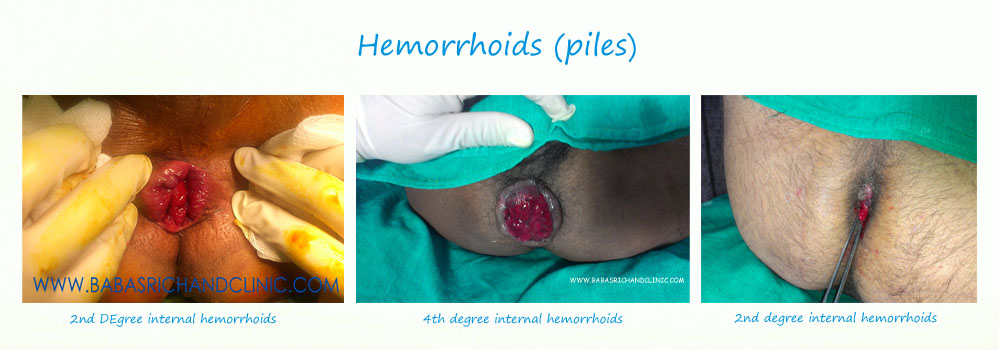Hemorrhoids (piles):
Hemorrhoids, emerods, or piles are swelling and inflammation of veins in the rectum and anus. The anatomical term “hemorrhoids” technically refers to “‘Cushions of tissue filled with blood vessels at the junction of the rectum and the anus.” However, the term is popularly used to refer to varicosities of the hemorrhoid tissue. Perianal hematoma are sometimes misdiagnosed and mislabeled as hemorrhoids, when in fact they have different causes and treatments.External hemorrhoids are those that occur outside the anal verge (the distal end of the anal canal). Specifically they are varicosities of the veins draining the territory of the inferior rectal arteries, which are branches of the pudendal artery. They are sometimes painful, and can be accompanied by swelling and irritation. Itching, although often thought to be a symptom of external hemorrhoids, is more commonly due to skin irritation.
External hemorrhoids are prone to thrombosis:
If the vein ruptures and/or a blood clot develops, the hemorrhoid becomes a thrombosed hemorrhoid.Internal hemorrhoids are those that occur inside the rectum. Specifically they are varicosities of veins draining the territory of branches of the superior rectal arteries. As this area lacks pain receptors, internal hemorrhoids are usually not painful and most people are not aware that they have them. Internal hemorrhoids, however, may bleed when irritated, usually due to constipation.Untreated internal hemorrhoids can lead to two severe forms of hemorrhoids.
Prolapsed and strangulated hemorrhoids:
Prolapsed hemorrhoids are internal hemorrhoids that are so distended that they are pushed outside the anus.If the anal sphincter muscle goes into spasm and traps a prolapsed hemorrhoid outside the anal opening, the supply of blood is cut off, and the hemorrhoid becomes a strangulated hemorrhoid. common people call it piles or Bawaseer.
Identified by:
- Bleeding with stool is the first complaint.
- Protruding mass on straining or defecation.
- Ultimately blood less causes anemia and associated weakness, lethargy, dizziness etc.
- Poor health low vitality, Poor performance at work.
Types of piles:
- First degree piles are swellings on the inside lining of your anal canal. They may bleed but can’t be seen from outside your anus.
- Second degree piles are larger than first degree piles. They stick out of your anus when you have a bowel movement, but go back inside on their own afterwards.
- Third degree piles hang down from your anus and only go back inside when you push them in.
- Fourth degree piles permanently hang down from your anus and you can’t push them back in. They may become very swollen and painful if the blood inside them clots.
Causes:
- Hereditary.
- Constipations and straining.
- Chronic dysentery and diarrheas.
- Aging.
- Faulty bowel function due to overuse of laxatives or enemas; straining during bowel movements.
- Spending long periods of time (e.g., reading) on the toilet.
Features:
- Bleeding.
- Prolapse of hemorroids.
- Discharge.
- Itching.
- Very occasionally pain.
Diet:
- Chill’s, excess sour, pungent and hot spices jaggary and stron alcohal cause bleeding.
- Maida, less fibre diet cause constipation
- Pregnancy – increased pressure on superior haemorhodal vein.
Managing of hemorrhoids:
- Constipation and straining to have bowel movements promote hemorrhoids and that hard stools can traumatize existing hemorrhoids.
- Soften your stools by increasing the fiber in your diet. Fiber is found in numerous foodstuffs including fresh and dried fruits, vegetables, grains, and cereals.
- Stool softeners and increased drinking of liquids is also recommended. Diarrhea is believed to aggravate the symptoms of hemorrhoids and it is recommended that diarrhea be controlled with fiber and anti-motility drugs.
- Many over-the-counter products are sold for the treatment of hemorrhoids. These often contain the same drugs that are used for treating anal symptoms such as itching or discomfort. Products used for the treatment of hemorrhoids are available as ointments, creams, gels, suppositories, foams, and pads. Most products contain more than one type of active ingredient.


